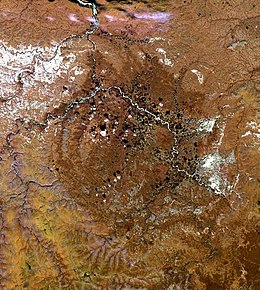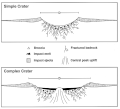포피가이 충격 구조
Popigai impact structure| 포피가이 충격 구조 | |
|---|---|
 포피가이 분화구의 랜싯 이미지 | |
| 충격 크레이터/구조물 | |
| 자신감. | 공정. |
| 지름 | 90km(56mi) |
| 나이 | 35.7 ± 0.2 Ma 에오세 말기 |
| 노출됨 | 네. |
| 드릴링됨 | 네. |
| 볼라이드형 | 혼드라이트 |
| 위치 | |
| 좌표 | 71°39'N 111°11'E/북위 71.650°111.183°좌표: 71°39'N 111°11'E / 71.650°N 111.183°E / |
| 나라 | 러시아 |
| 주 | 크라스노야르스크 |
포피가이 충돌 구조물은 러시아 시베리아 북부에 있는 충돌 분화구의 침식된 잔해입니다.그것은 [1][2]지구상에서 네 번째로 큰 확인된 충격 구조로서 Manicouagan 구조와 동점입니다.약 3천 5백만 년 전 에오세 후기(프리아본기)[3][4]에 거대한 볼리드 충돌로 지름 100km의 분화구가 만들어졌습니다.그것은 에오세-올리고세 멸종 [5]사건과 연관이 있을 수 있습니다.
이 구조물은 카탕가의 전초기지에서 동쪽으로 300km, 아나바르 고원의 NNE인 노릴스크에서 북동쪽으로 880km 떨어진 곳에 있습니다.그것은 특별한 지질학적 유산의 [6]장소인 지질공원으로 유네스코에 의해 지정되었습니다.포피가이 충돌 분화구가 약 3천 5백만 년 전의 체서피크 만과 톰스 캐년 충돌 [3]분화구와 동시에 형성되었을 가능성은 거의 없습니다.
수십 년 동안, 포피가이 충돌 구조는 고생물학자들과 지질학자들을 매료시켰지만, 그곳에서 발견된 다이아몬드 때문에 전체 지역은 완전히 금지되어 있었습니다.그러나, 1997년에 대규모 탐사가 이루어졌고,[6] 이것은 구조에 대한 이해를 크게 발전시켰습니다.충돌체는 이탈리아의 분출물 층에 기반을 둔 H 콘드라이트 소행성이었을 것으로 추정되며, 충돌체의 지름은 [7]수 킬로미터였을 것으로 생각됩니다.
충격으로 인한 충격 압력은 충격 지점에서 반경 13.6km(8.5mi) 이내의 지면에 있는 흑연을 즉각적으로 다이아몬드로 변형시켰습니다.이 다이아몬드들은 보통 지름이 0.5~2mm이지만, 몇몇 예외적인 표본들은 크기가 10mm입니다.다이아몬드는 원래 흑연 알갱이의 표 형식과 원래 결정의 섬세한 [6]줄무늬를 이어받았습니다.
다이아몬드 광상
대부분의 현대 산업용 다이아몬드는 인공적으로 생산됩니다.포피가이의 다이아몬드 매장지는 멀리 떨어져 있고 인프라가 부족하기 때문에 채굴되지 않았으며 합성 [9]다이아몬드와 경쟁할 가능성이 낮습니다.포피가이의 많은 다이아몬드들은 육각형 [10]격자를 가진 탄소의 동소체인 결정질 론즈데라이트를 포함하고 있습니다.순수한 실험실에서 만든 론스데일라이트는 일반 [11][9]다이아몬드보다 최대 58% 더 단단합니다.이러한 종류의 다이아몬드는 운석이 흑연 퇴적물에 빠른 [10]속도로 부딪힐 때 생성되는 것으로 생각되기 때문에 "임팩트 다이아몬드"라고 알려져 있습니다.그들은 산업적 용도가 있을 수 있지만 [12]보석으로 적합하지 않습니다.
게다가,[13][14] 순수한 론다일라이트보다 훨씬 더 단단한 다이아몬드와 론다일라이트의 조합인 탄소 폴리모프가 분화구에서 발견되었습니다.
참고 항목
레퍼런스
- ^ "Popigai". Earth Impact Database. Planetary and Space Science Centre University of New Brunswick Fredericton. Retrieved 2017-10-09.
- ^ Masaitis, Victor L. (2003). Popigai Crater: General Geology. Springer. pp. 81–85. ISBN 978-3-540-43517-4.
- ^ a b Deutsch, Alexander; Christian Koeberl (2006). "Establishing the link between the Chesapeake Bay impact structure and the North American tektite strewn field: The Sr-Nd isotopic evidence". Meteoritics & Planetary Science. 41 (5): 689–703. Bibcode:2006M&PS...41..689D. doi:10.1111/j.1945-5100.2006.tb00985.x.
- ^ Armstrong, Richard; S. Vishnevsky; C. Koeberl (2003). U-Pb Analysis of zircons from the Popigai impact structure, Russia: First Results. Springer. pp. 99–116. ISBN 978-3-540-43517-4.
- ^ "Russia's Popigai Meteor Crash Linked to Mass Extinction". June 13, 2014.
- ^ a b c Deutsch, Alexander; V.L. Masaitis; F. Langenhorst; R.A.F. Grieve (2000). "Popigai, Siberia—well preserved giant impact structure, national treasury, and world's geological heritage". Episodes. 23 (1): 3–12. doi:10.18814/epiiugs/2000/v23i1/002.
- ^ Schmitz, Birger; Boschi, Samuele; Cronholm, Anders; Heck, Philipp R.; Monechi, Simonetta; Montanari, Alessandro; Terfelt, Fredrik (September 2015). "Fragments of Late Eocene Earth-impacting asteroids linked to disturbance of asteroid belt". Earth and Planetary Science Letters. 425: 77–83. doi:10.1016/j.epsl.2015.05.041.
- ^ Ohfuji, Hiroaki; Irifune, Tetsuo; Litasov, Konstantin D.; Yamashita, Tomoharu; Isobe, Futoshi; Afanasiev, Valentin P.; Pokhilenko, Nikolai P. (2015). "Natural occurrence of pure nano-polycrystalline diamond from impact crater". Scientific Reports. 5: 14702. Bibcode:2015NatSR...514702O. doi:10.1038/srep14702. PMC 4589680. PMID 26424384.
- ^ a b "Diamonds Beneath the Popigai Crater -- Northern Russia". geology.com. 23 September 2012. Retrieved 24 September 2012.
- ^ a b "Russia declassifies deposit of impact diamonds". ITAR-TASS. 17 September 2012. Archived from the original on 20 September 2012. Retrieved 17 September 2012.
- ^ Pan, Zicheng; Sun, Hong; Zhang, Yi & Chen, Changfeng (2009). "Harder than Diamond: Superior Indentation Strength of Wurtzite BN and Lonsdaleite". Physical Review Letters. 102 (5): 055503. Bibcode:2009PhRvL.102e5503P. doi:10.1103/PhysRevLett.102.055503. PMID 19257519.
- Lisa Zyga (12 February 2009). "Scientists Discover Material Harder Than Diamond". Phys.org.
- ^ 외계 다이아몬드에 대한 장단점 2014-12-22 Wayback Machine에 보관된 "거칠고 세련된 다이아몬드 및 보석 시장에 대한 정보와 분석"
- ^ El Goresy, Ahmed; Dubrovinsky, Leonid S; Gillet, Philippe; Mostefaoui, Smail; Graup, Günther; Drakopoulos, Michael; Simionovici, Alexandre S; Swamy, Varghese; Masaitis, Victor L (2003). "A new natural, super-hard, transparent polymorph of carbon from the Popigai impact crater, Russia". Comptes Rendus Geoscience. 335 (12): 889. Bibcode:2003CRGeo.335..889E. doi:10.1016/j.crte.2003.07.001.
- ^ Baek, Woohyeon; Gromilov, Sergey A.; Kuklin, Artem V.; Kovaleva, Evgenia A.; Fedorov, Alexandr S.; Sukhikh, Alexander S.; Hanfland, Michael; Pomogaev, Vladimir A.; Melchakova, Iuliia A.; Avramov, Paul V.; Yusenko, Kirill V. (2019-03-13). "Unique Nanomechanical Properties of Diamond–Lonsdaleite Biphases: Combined Experimental and Theoretical Consideration of Popigai Impact Diamonds". Nano Letters. 19 (3): 1570–1576. Bibcode:2019NanoL..19.1570B. doi:10.1021/acs.nanolett.8b04421. ISSN 1530-6984. PMID 30735045.







